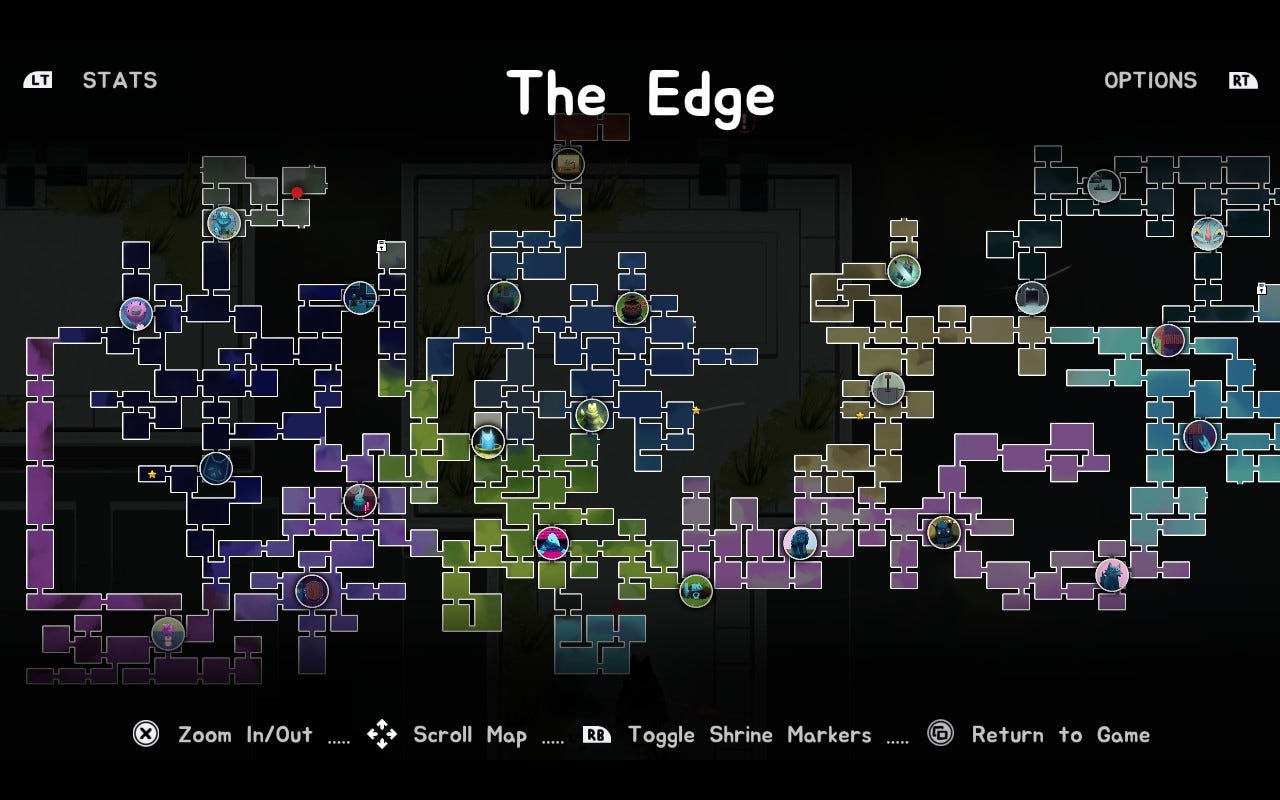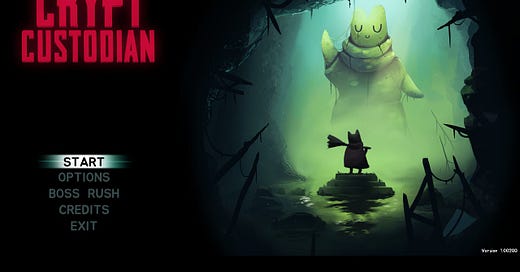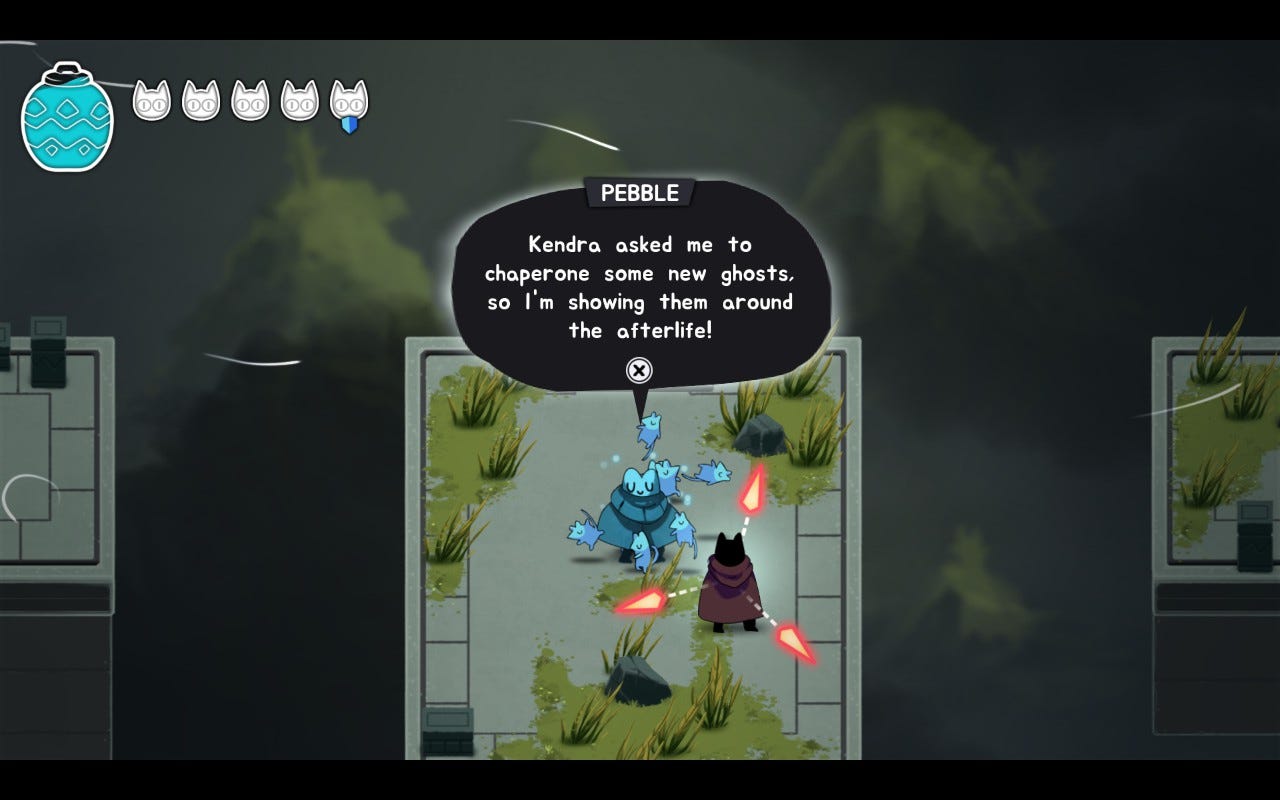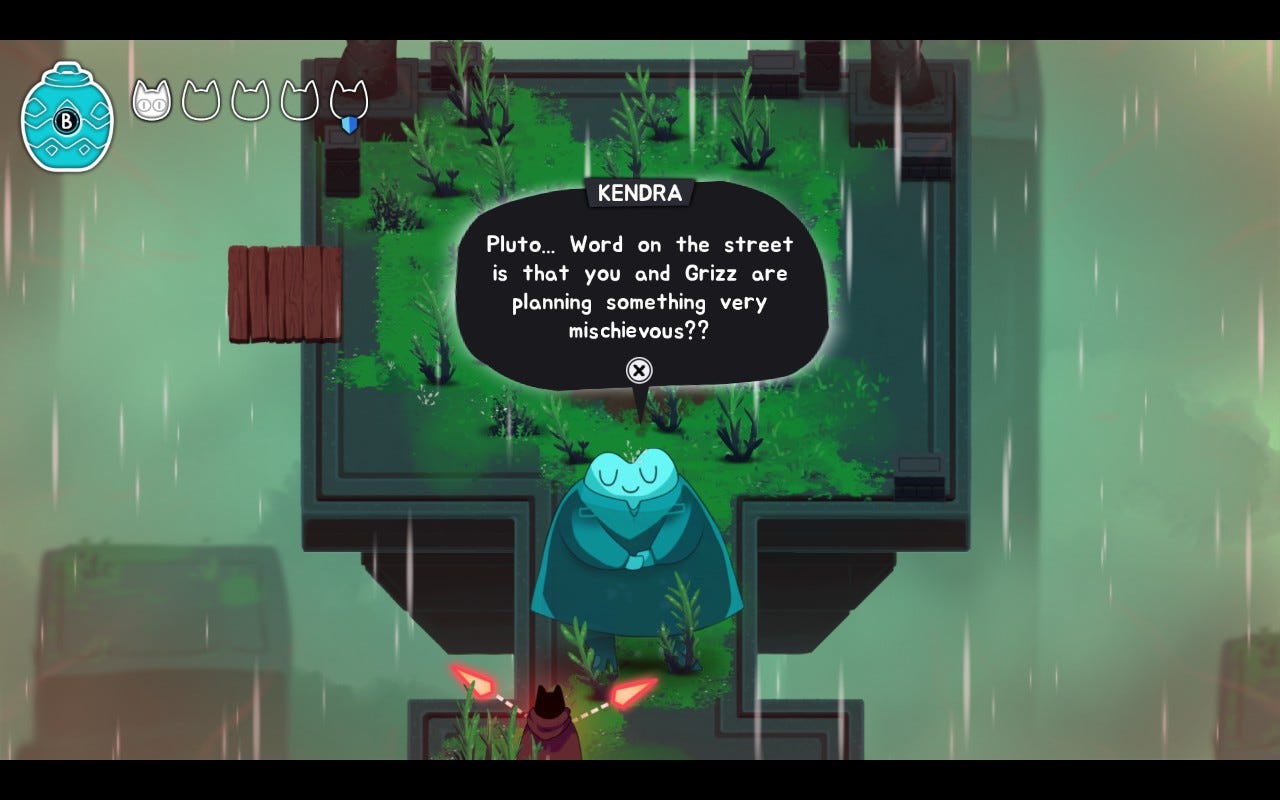Crypt Custodian (2024) turns trash into community [Review]
Grab a broom and make some friends!
There stands Minos with terror, and he snarls.
He examines the faults of those that enter;
He judges and proclaims as he clutches.
I say, when an evil-born soul
Comes before him, that soul confesses everything,
And that expert of iniquities
Sees what place in Hell is fit for them;
He circles himself with his tail as many times
As the amount of Circles he wishes that soul to be sent down.
Dante, Inferno, V.4-12 (my translation is pretty literal; feel free to look at others for better poetry)
Reviews on Play Moore take two forms:
The Review, in which I give some non-spoiler thoughts
The Report, in which I have a longer spoiler-filled discussion on the game’s main themes.
My review is partly based on my enjoyment and partly based on how I might use it in a classroom. Generally speaking, I will have enjoyed every game I review. I don’t necessarily claim a game is “good.”
Review
The basics
Playtime - about 15 hours for the main story
Difficulty - approachable but requires some practice
Platform - I played on Steam Deck; it’s available on all major systems
no major content warnings, but it is about a bunch of animals who had died
so it’s just a little sad
“Whoa” Factor - 4
Recommendation - yes
The conceit
Games about the afterlife seem to be everywhere now. I do wonder if some greater cultural shift has happened.
Today, I’m going to talk about Crypt Custodian, Top Hat Studios’s newest isometric metroidvania.1 I was sold on the cute art design, the silly premise (you’re a cat doomed to sweep the underworld for eternity), and the promise of exploration and approachable combat.
I was not let down. This game was a wonderful 15 hours for me.
You play as Pluto, a cat who has tragically entered the underworld, waking by some rushing water. Pluto walks around for a bit and discovers that statues are blocking the way to the Temple, where (you are told) he must go to be judged.
Pluto finds a broom and uses it to remove the bothersome statues. It’s the only way.
Kendra is the judge in the Temple. While at first pleasant and agreeable, she quickly becomes agitated at Pluto’s (the player’s) decision (requirement) to destroy those statues (of her) out front. She denies Pluto access to the Temple and instead condemns him to an afterlife of labor: to clean up the underworld with his broom as repayment for breaking the statues and making a mess.
The world is dangerous outside the temple. This is a punishment, after all. So Pluto needs to kill some mobs in order to clean the massive trash piles everywhere. Funny enough, after a couple hours, I met Kendra again, and she admonished me for “having fun” when I was supposed to be working.2
Thus begins Pluto’s journey. Make friends and explore! It’s time to create a community.
The playing
The game itself is relatively simple, based on common tropes from metroidvanias and other action-adventure subgenres. The broom is Pluto’s weapon; you have a light attack, a special, a jump, and a dash. You gain currency (trash bits) from defeated enemies and from those trash piles, and you can use the currency to buy upgrades.
An economy of trash makes sense. The first friend Pluto meets is Pebble, who was also doomed to an afterlife of the custodial arts.
Pebble is great. He made a shrine to Pearl, who has not yet followed him into the afterlife. Pearl’s Shrine is one of the earliest areas that teaches players how to navigate the map, adapt to new enemy types, and find bonus objects off the main paths.
The main goal in the game is to make friends. Very literally, by cleaning the underworld and defeating monsters, Pluto creates a community bound by loyalty and a shared fate. More on this in the spoiler section below.
The gameplay loop is satisfying, and boss fights are difficult enough. You need to pay attention and practice, but if you have some experience you should be able to get through without too many issues. You’ll die, but the respawn is very quick, and traversing back to where you died is rarely onerous.
The music fits very well to each area. There is no shortage of wonderful tracks, including serene vibes for easy exploration and intense energies for boss fights. The sound design as a whole adds into the fuller aesthetic mix without being distracting. It sucks you in.
The map itself is massive for the relative size of the game. Exploration and narrative progression will require you to revisit areas, remember places you couldn’t get to before, and try new things. Don’t be afraid to just walk around.

Thankfully, the fast travel system is super easy, and load times are almost non-existent. I was impressed with the game’s optimization and density.
Crypt Custodian gets 4 “Whoa” points from the times I was impressed at a boss or level design, enjoyed a certain quip in dialogue, or discovered something unexpected. Check it out.
The teaching
I wouldn’t assign this for students to play outside of class, but I’d show it off. It presents its major themes quickly at the start of the game, so we could have some interesting conversations right off the bat.
I think it’s Top Hat Studios’s best effort so far, personally, and thematically it’s both appropriate and accessible for a university lecture.
Crucially, the dialogue is effective. It’s not overly poetic or unique, but it does exactly what it needs to do (give information to the player and allow each character to have their own voice) without sounding stilted or hello-fellow-kids. The short conversations with Pluto’s friends are often funny, and they convey with punctuation—in a style not dissimilar to how I text—more than words alone.
For example, there are many signs that say NOT to go east to see what Grizz is up to. He’s doing something bad, you see.
So obviously, you go over there, and he is [redacted]. He then says, “You better not snitch on me!!” The double exclamation point really is nice to see.
For these reasons and more, Crypt Custodian would be interesting to discuss as part of a unit on how games teach the player how to play, but it’s a little too long and requires a little too much precise and urgent gameplay to have intro-level students play on their own. B+.
Report - major spoilers below
Themes
I quoted Dante up there because Kendra acts in a similar manner as Minos. She judges all who enter her chamber. Unlike Minos, it seems that she is in charge of both the Temple (Heaven/Paradise) and the lands outside of it (Hell). Like Minos, she knows everything that happened to the soul standing before her.3
Grizz, when you meet him, is digging a hole under a fence in order to break into the Temple. That’s right. We’re assaulting Heaven. The digging is going slow, and he is not sure what to do on the other side, so Pluto promises to bring 10 friends along with him. They can attack together. Community.
To me, the coolest part is that no one refuses friendship when it is offered. It seems that the worst fate of cleaning up the underworld (other than the constant onslaught of enemies and trash) is isolation.4 Neat stuff!
With all friends assembled at Grizz’s dig-site, the Breaking of the Temple begins.
You might have guessed it by now. The Temple is empty. Kendra lives there alone, and it’s filled with garbage—her garbage. We knew already that she sucked, of course: she places statues of herself along the entry path so that every new soul must break them in order to reach their judgment in the first place.
But we see now her true treachery. Kendra denied access to the Temple to every single soul that entered her domain. She is a Minos with vicious politeness.5
She exists, only herself, one, alone, in a supposed paradise, but it’s disgusting and bleak. The only thing that separates her existence from those she deemed unworthy is the deeming. She doesn’t have to clean, but she lives in filth. She moves that filth outside, and her banished workers clean it for her.
This makes me think of that common critique of modern capitalism: Western countries create so much waste that we ship it off to other countries. That way we don’t have to deal with it ourselves, and we can keep living lives of reckless consumerism.
Themes so far:
Community is what makes a Heaven, and isolated work a Hell
Those who create unjust systems are not fit to judge
Offshoring garbage creates work for others
You can turn work into play if the work and your mindset allow
The answer is friends
There is plenty more to discuss, but I’ll leave it here.
Have you played this game? What did you think? Who was your favorite NPC? Did you notice anything I didn’t mention? Let me know!
Be at peace.
Top Hat is run by Kyle Thompson, so you may see that name as the creator.
I’ve noticed a trend in recent media that relates Hell and work. I wonder what that’s about.
Consider also Maya Rudolph’s portrayal as The Judge from The Good Place.
Kendra admits at one point to shipping the trash in. It doesn’t magically appear.
Remember: just because someone is calm and using level-headed language does not mean they are nice. Fascists don’t always yell. They are usually quite composed when they remove protections for the poor.







I haven't heard of this game - but it looks super neat! I am a big fan of metroidvanias for their explore-and-reward gameplay loop, but I can probably count the number of games in this genre (sub-genre?) that use that gameplay loop to the advantage of the narrative. Animal Well is one that comes to mind, with its mysterious environmental storytelling encouraging a curious approach from the player. Some Metroids also do a good job of this. It sounds like this game might also fall into that basket. Great read!